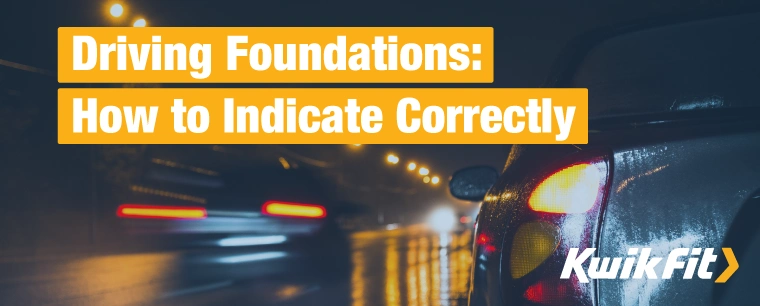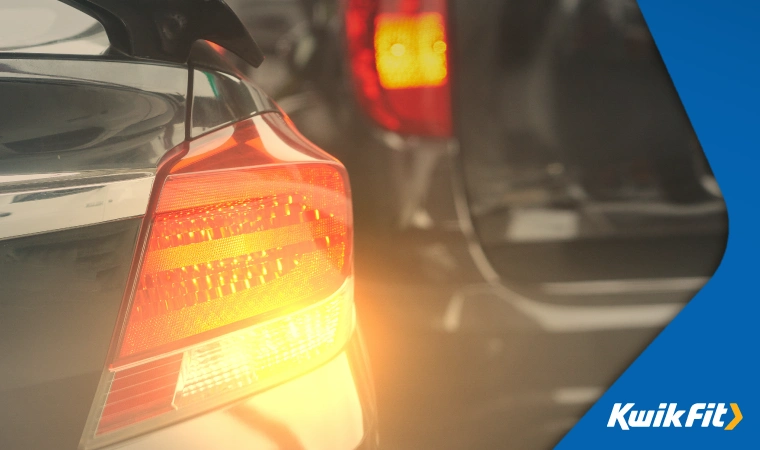Driving Foundations: How to Indicate Correctly
Jack Dreyer | Friday 6th December 2024 9:30am

Using your vehicle's indicators isn't just about following the rules; it's a crucial way to communicate your intentions to other drivers. Despite this, signalling is often overlooked or forgotten, leading to moments of confusion and potential danger on the road.
Ensuring you use your indicators correctly is more than just a habit or a requirement; it's a key part of safe driving that lets everyone on the road, including pedestrians, know what youíre going to do next.
In this blog, we cover why indicating is so important, the right way to do it, and the impact it has on road safety and driving etiquette. Let's get back to basics and learn how to use our signals effectively, making the roads safer for everyone.
The basics of indicating
Ensuring your vehicle's indicators are working correctly is critical for your own safety and the safety of other road users too. The basics of indicating are grounded in the principle of communication on the road - they are an essential tool for conveying your intentions to other drivers, cyclists, and pedestrians.
When to indicate
It is crucial to indicate to alert others around you of your intention to turn, change lanes, or perform certain manoeuvres that involve directional change. Hereís a comprehensive list of when you should be using your indicators:
- When moving on or off from the side of the road.
- Before turning left or right.
- When changing lanes and merging, including overtaking cars or cyclists.
- When signalling at roundabouts.
- During parking manoeuvres.
The key to effectively indicating lies in timing ó signals should be activated well in advance of your action but not so early that they confuse other road users about when the action will take place. If youíre turning or taking an exit, for example, be sure to indicate at an appropriate time to avoid confusing other road users into thinking youíre turning earlier than you actually intend to (EG: at an earlier exit).

Why indicating correctly is important
Indicating correctly is paramount for several crucial reasons ó namely, road safety, legal compliance, and general driving etiquette.
Safety
The primary importance of correctly using turn signals cannot be overstressed when it comes to safety. Indicating allows other road users to anticipate your next move, significantly reducing the likelihood of collisions. For example, if you signal before changing lanes, it gives cyclists, motorists, and pedestrians time to adjust their speed or position to maintain a safe distance.
Legal requirements
The law requires drivers to use their turn signals before turning, changing lanes, or performing certain manoeuvres. Failing to indicate can lead to traffic violations, fines, and even points on your driver's licence. Legal mandates underline the universal acknowledgement of the importance of turn signals in maintaining road safety.
Etiquette and road consideration
Using your turn signals is also a matter of courtesy. It shows respect for other road users by acknowledging their right to be informed of your driving manoeuvres. This encourages others to also communicate their intentions effectively, which can help alleviate traffic congestion and reduce road rage incidents.
Typically, if someone has slowed down to let you change lanes or overtake, a quick hand up is recognised as a thank you whilst driving and is commonplace in the UK. Whilst some use their hazard lights or flash their headlights, it is not recommended as using your hazard lights inappropriately can get you fined and flashing your headlights is against the highway code.
Common mistakes to avoid
Among the common mistakes to avoid when it comes to indicating is not indicating at all. Not using your indicators as a turn signal at all can lead to dangerous situations, as other road users have no warning of your intentions to turn or change lanes. This lack of communication can result in sudden braking, swerving, and ultimately, collisions, as others are caught off guard by your unexpected manoeuvres.
Late indicating is also a common mistake people make. Indicating too late doesn't give other drivers or pedestrians enough time to react appropriately, which may cause chain reaction accidents.
Practical tips and reminders
When it comes to indicating properly, incorporating a few practical tips and reminders into your driving habits can significantly enhance road safety and communication. Hereís some simple tips and reminders for indicating effectively:
- Check your indicators regularly - Regularly ensure that all your turn signals are working correctly. This includes front, back, and side indicators. A quick check before you start driving can prevent signalling issues on the road.
- Signal early enough - Ensure you indicate with enough time to give other drivers and pedestrians notice of your intentions. That being said, signalling too early can sometimes confuse others if thereís an intersection or driveway before your actual turn.
- Practise good habits - Even if you believe no one is around, always use your signal. Other drivers, cyclists, or pedestrians might be in your blind spot or somewhere you canít see.
- Be mindful of signal cancellation - Some vehicles automatically cancel the signal after a turn or even before if you make a slight turn, but it's always good to manually ensure that your signal has stopped after the manoeuvre as accidentally leaving your signal on can mislead others.
- Educate yourself on the rules - Familiarise yourself with the changes in regulations regarding how and when to use your turn signals. The Highway Code is adapted every year and even minor changes may impact your everyday travels.
Keeping drivers safe on the road
If you are in any doubt, or find that you have a blown or faulty indicator bulb, pop into your nearest Kwik Fit centre where our trained staff can supply and fit these for you. Donít chance it, check your bulbs today.
If you have been experiencing any problems with your indicators or just feel you need a check up to make sure your car is roadworthy, get in touch with our team of experts today.
For more advice on navigating roads and driving best practices, be sure to keep up with the Kwik Fit blog.
Any facts, figures and prices shown in our blog articles are correct at time of publication.
Featured Articles
Is it Illegal to Drive With One Headlight?
Saturday 19th July 2025
Wondering if itís illegal to drive with one headlight? Learn about the safety risks and penalties of illegal blown bulbs and why you should fix them promptly.
Air Con in EVs & Hybrids: Experts Answer Your Questions
Monday 30th June 2025
Does air con drain EV batteries? Can you use the air con while charging an electric car? Find out the answers to these questions & more from Kwik Fitís experts.
Why Is Your Car Making a Noise? Fixes & Tips
Friday 13th June 2025
When your car starts making unexpected noises, it can certainly be quite disconcerting; it may be nothing to worry about, but hereís what you need to know.









